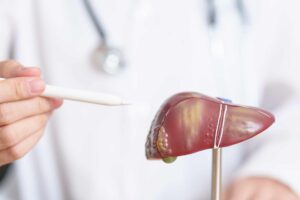What is already known on this topic
Babies born by C-section have an increased risk of developing immune and metabolic disorders, which have been associated with the gut microbiota. Several studies have shown that wiping a baby’s mouth, face and skin with their mother’s vaginal fluids after a C-section, also known as maternal-child microbial seeding, may partially restore the gut microbiota.
What this research adds
The review discusses the rationale for maternal-child microbial seeding, the current evidence of the efficacy of such interventions and the controversies surrounding them.
Conclusions
The authors conclude that large-scale, randomized controlled trials of maternal-child microbial seeding are needed to verify whether the intervention is safe and improves health outcomes in babies born by C-section.
Babies born by C-section have an increased risk of developing immune and metabolic disorders, which have been associated with an altered gut microbiota. Wiping a baby’s mouth, face and skin with their mother’s vaginal fluids after a C-section may partially restore the gut microbiota, recent studies have found. However, there are still many caveats surrounding this type of intervention, known as maternal-child microbial seeding.
In a Forum article published in Cell Host & Microbe, Suchitra Hourigan at the US National Institutes of Health and her colleagues discuss the rationale for maternal-child microbial seeding, the current evidence of the efficacy of such interventions and the controversies around them.
“If maternal-child microbial seeding improves health outcomes, it may be a simple, cost-effective public health strategy that could reduce the prevalence of C-section-associated diseases,” the authors say.
Seeding rationale
More than 30% of babies in the United States are born by a C-section. These babies aren’t colonized by microbes as they pass through the birth canal. This exposure to vaginal microbes is thought to be critical for the subsequent development of the infant microbiota.
Indeed, babies born by C-section show differences in microbiota acquisition and development compared with those born by vaginal delivery, with beneficial bacteria such as Bacteroides and Bifidobacterium being underrepresented, and bacteria that could cause diseases being overrepresented in the gut of C-section infants.
The associations of C-section delivery with chronic inflammatory diseases is thought to be in part mediated by the gut microbiota. Several studies have suggested that seeding infants with microbes from their mother’s vaginal fluid can improve health outcomes. During this process, known as maternal-child microbial seeding, a sterile gauze is inserted into the mother’s vagina prior to C-section delivery and then wiped over the newborn’s mouth, face and skin.
Microbiota effects
A 2016 study showed that maternal-child microbial seeding made the skin and gut microbiota of babies born by C-section more closely resemble that of vaginally born babies. More recently, a larger study showed that C-section-born babies who received vaginal seeding had microbiota trajectories that aligned with vaginally born babies.
A 2021 trial studied the effect of orally administering a mother’s vaginal fluid to her infant shortly after C-section delivery. However, oral administration of maternal vaginal microbes did not seem to alter the gut microbiota of infants. Another study showed that babies seeded with maternal fecal matter mixed with breast milk had increased levels of Bacteroides and Bifidobacterium species in their guts.
Finally, studies in mice indicated that the beneficial effects of maternal-child microbial seeding were dampened if the mother was obese or had an altered vaginal microbiota. “This suggests that not only does the composition of the inoculate matter, but also the prenatal environment shapes the post-natal response to inoculation,” the authors say. “Translationally this may be of importance, as not all C-section-delivered infants may benefit from maternal-child seeding equally, and maternal prenatal history may be important to collect in clinical trials to provide insight into post-natal responses to seeding.”
Safety and controversies
Studies of vaginal seeding have reported no transmission of infection from vaginal fluids to newborn babies. However, the authors note, “a potential transmission of [Herpes Simplex Virus] has been reported with vaginal seeding outside of an institutional review board-approved research protocol.” This, they add, “emphasizes that for now vaginal seeding should only performed in an approved research trial where mothers are carefully screened for infections and safety data closely followed.”
Another controversy surrounding maternal-child microbial seeding concerns the idea of the ‘sterile womb’. Some researchers have proposed that the first exposure of infants to the maternal microbiota occurs in the uterus, well before birth. This would make the concept of vaginal seeding less important.
Other researchers argue that other factors associated with C-section, such as delayed breastfeeding, may also influence the developing microbiota, thus changing the risk for subsequent diseases. “The possibility of residual or unmeasured confounding factors cannot be completely ruled out in observational study designs,” the authors say.
Future directions
So far, several observational studies have suggested that maternal-child microbial seeding can at least in part restore the microbiota development of infants born by C-section. However, the authors note, “no randomized controlled trials have shown that vaginal seeding changes the infant microbiome, let alone improves health outcomes.”
What’s more, as some babies born by C-section may not be able to receive maternal-child microbial seeding, it would be important to figure out the most effective combination of microbes to develop targeted interventions for these infants.
The authors conclude that large-scale, randomized controlled trials of maternal-child microbial seeding are needed to verify whether the intervention is safe and improves health outcomes in babies born by C-section. “These trials are currently underway,” they say











